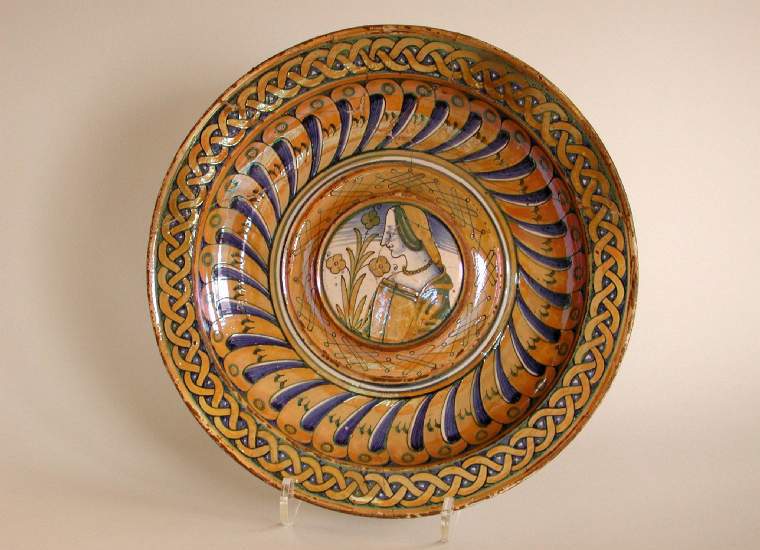Current Location: In storage
Maker(s)
Maker:
Unidentified Deruta pottery
Entities
-
Basin
- shallow basin for ewer
- dish for a ewer
Categories
Description
Pale buff earthenware, tin-glazed overall. Painted in blue and with brassy-yellow lustre.
Shape 70, but deeper. Circular with narrow rim, wide shallow well with a slightly convex boss in the middle, surrounded by a circle rib, a sloping concave zone and an indented circle.
On the boss within a blue circle, a woman half-length in profile to left faces a plant with three flowers. The boss is surrounded by a broad lustre band decorated with blue interlace, outside which is a series of concentric circles: blue, reserved white, blue, lustre and blue. The sides are decorated with slanting pseudo-gadroons and the rim has two continuous interlacing lines. A lustre band encircles the edge. On the back are four spaced concentric lustre circles.
Notes
History note: A. Wylie; Frederick Leverton Harris (1864-1926)
Legal notes
F. Leverton Harris Bequest, 1926
Measurements and weight
Diameter: 31.5 cm
Height: 3.5 cm
Acquisition and important dates
Method of acquisition: Bequeathed
(1927)
by
Harris, Frederick Leverton
Dating
16th Century, Early
Renaissance
Circa
1500
-
1530
Note
Shallow basins with a central boss (bacili da acquareccia) were intended to accompany ewers, although no sets appear to have survived together. They were produced throughout the first half of the sixteenth century, and lustred examples survive in great numbers. Very few can be dated, even approximately with certainty. One of the earliest, in the British Museum, is decorated on the boss with the arms of a Montefeltro Duke of Urbino and was presumably made before 1508 when Francesco della Rovere succeeded to the dukedom. another basin at the Musée de la Renaissance at Ecouen, bears the arms for one or other of the Medici Popes, Leo X (1513-21) or Clement VII (1523-34).
Many of these basins are decor¬ated in the centre with a woman demurely facing to right or left towards a flowering plant, surrounded by a selec¬tion of stock patterns on the sides and rim, such as mock gadroons, scales, pointed rays and sty¬lized plants, wreaths of formal flowers and geometrical motifs. On some basins the flowers in front of the girls resemble pinks, which, like carnations, were symbols of love, so it seems likely that these were betrothal or wedding gifts, although not necessarily so. In the late fourteenth century, Margherita, the wife of the merchant, Francesco Datini of Prato (d. 1410), was asked to take 'a bowl and an ewer, such as is customary to give to girls' to the birthday party of one of her friend's daughters. At that time the ewer and basin would almost certainly have been metal, but it seems probable that, if this custom persisted maiolica would have been acceptable. A maiolica basin in an Italian private collection has the girl's name GIROLEMA painted across the boss.
It is difficult to date these basins other than by matching the borders with datable pieces of other types, or by the costume of the girls in the central medallion, which, because of the conservatism of Deruta decorators, is probably not very accurate. Nevertheless, it seems significant that the Louvre's relief moulded basin dated 1546, and another undated in the Lehman collection at the Metropolitan Museum of Art, feature girls wearing a different style of dress and turban-like caps. This fashion can be seen in portraits of the 1520s, and on bella donna dishes of the 1530s and early 1540s. It therefore seems likely that basins like this example and C.84-1961, which feature a Peruginesque girl, were likely to have been made before about 1530.
There are examples in the City Museum and Art Gallery, Stoke-on-Trent (27 P 53); the Musée des Antiquités de la Seine-Maritime, Rouen, the V. & A., the Walters Art Museum, Baltimore, the Louvre, the Musée National de la Renaissance, Écouen, the Indianapolis Museum of Arts, the Nationalmuseum, Stockholm, the Metropolitan Museum of Art, New York, the Galeazzi collection, Terni, the Museum für Kunst und Gewerbe, Hamburg, the British Museum, and the Los Angeles County Museum, i(50.9.14.7).
School or Style
Renaissance
People, subjects and objects depicted
Components of the work
Decoration
composed of
high-temperature colour
( blue)
reduced pigment lustre
( silver-yellow, appearing brassy-yellow)
tin-glaze
Materials used in production
Earthenware
Techniques used in production
Moulding
: Pale buff earthenware, moulded, and tin-glazed overall. Painted in blue and with brassy-yellow lustre.
Tin-glazing
Inscription or legends present
Inscription present: rectangular with cut corners and blue printed border
- Text: 'M24' in ink, 'Leverton/Harris/1926' in pencil
- Method of creation: Hand-written in blue-black ink and pencil
- Type: Label
References and bibliographic entries
Identification numbers
Accession number: C.84-1927
Primary reference Number: 48529
Stable URI
Audit data
Created: Saturday 6 August 2011
Updated: Tuesday 30 April 2024
Last processed: Tuesday 2 September 2025
Associated departments & institutions
Owner or interested party:
The Fitzwilliam Museum
Associated department:
Applied Arts





